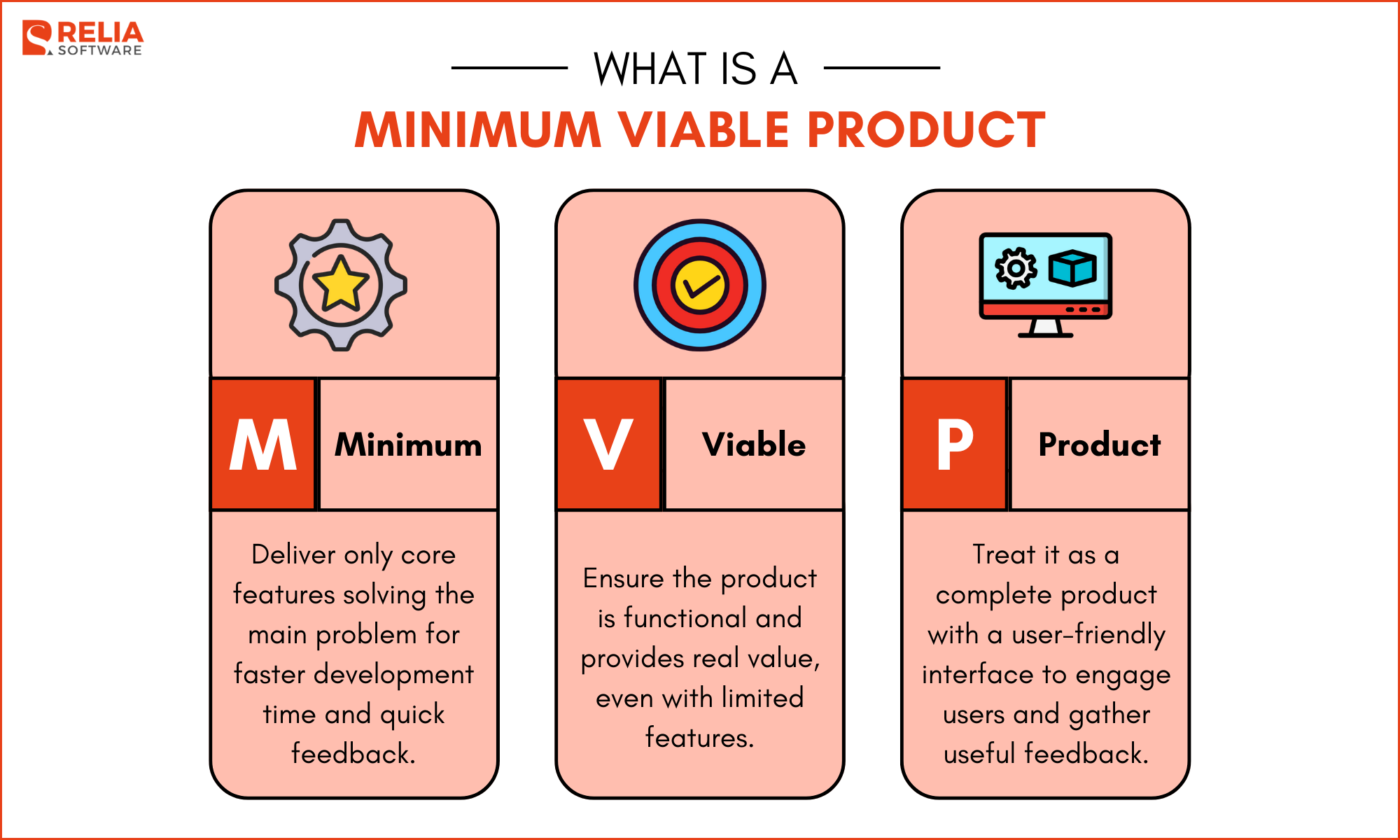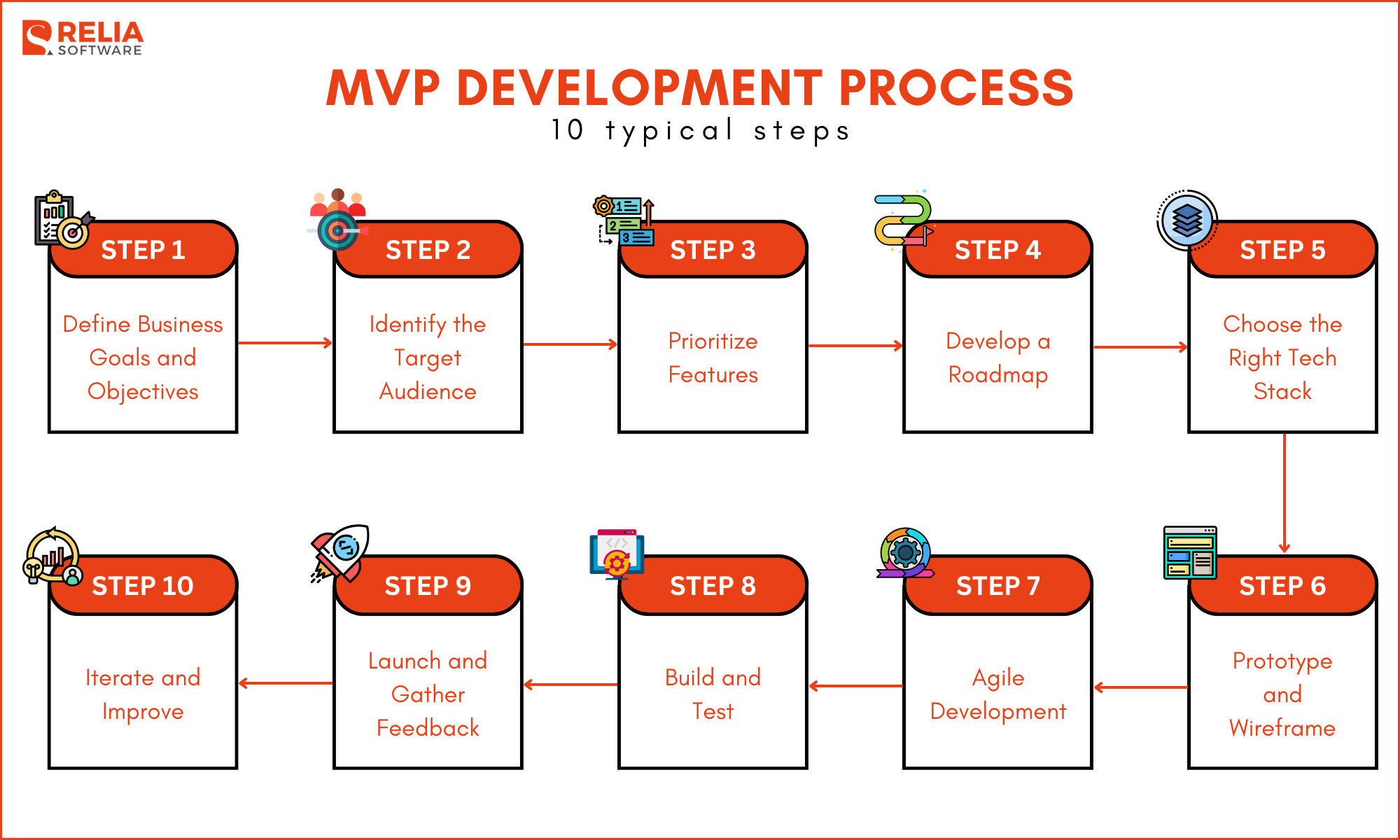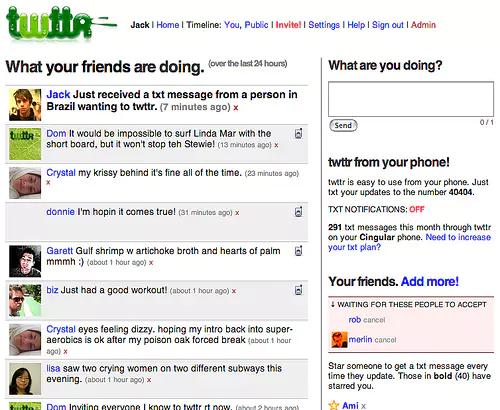Launching software products successfully in a growing digital environment requires a smart and agile approach. Traditional development, with its long timeframes and heavy planning, can postpone and increase risk.
Fortunately, Minimum Viable Product (MVP) is a great solution for quickly bringing ideas to market. MVPs let developers start early, test their ideas, gather user feedback, and quickly improve their products. This blog will discuss MVP benefits, development phases, and success tactics.
>> Read more: A Complete Guide to the Software Development Lifecycle
What Does MVP Mean in Software Development?
A Minimum Viable Product (MVP) is a simple version of a software product that only has the core features to satisfy early users and validate a new idea. It is used to test assumptions, gather feedback, and iterate quickly. Thus, MVPs can prevent large investment in full-scale development before understanding user demands.
Designed by Eric Ries using his Lean Startup approach, an MVP stresses learning and adaptation based on actual experience. Teams release the most important features to observe user reaction instead than creating a whole product up front. This feedback loop guarantees that next development meets user expectations, helping to improve the product and lower risk.
Lean and Agile methodologies, which emphasize fast iteration and ongoing development, commonly use the MVP concept. By starting with a minimum set of features, focusing on a viable product that delivers value, and treating the MVP as a real product, companies can make informed decisions about what features to develop next, ensuring a product that is both user-centered and cost-efficient.
>> Read more: 8 Software Development Life Cycle (SDLC) Methodologies

Benefits of Building an MVP for Startups, SMEs, and Large Enterprises
Startups
- Lean Validation: Startups often operate under tight budgets. MVPs allow them to validate a business idea with minimal resources, reducing financial risk and avoiding building features that customers don’t need.
- Fast Market Entry: Startups can gain an early competitive advantage by launching an MVP quickly and iterating based on feedback. This agility is really vital if you want to survive in competitive industries.
- Investor Attraction: An MVP with commercial appeal can get early-stage funding. You know, investors are more willing to invest in a product with proven user engagement and potential for growth. MVPs are a proof of concept, demonstrating your idea has merit.
SMEs
- Resource Balancing: MVPs help SMEs to prioritize investments by focusing on important features, thereby reducing waste, and optimizing return on investment (ROI). They can test new business opportunities without wasting resources.
- Niche Market Testing: Through MVPs, SMEs can safely test new markets, technologies, or features, allowing for rapid changes depending on market signals without investing too much.
- Customer-Centric Iteration: MVPs gather feedback from key audiences to improve the product. The product development thus meets user expectations and builds customer loyalty.
Large Enterprises
- Risk Mitigation for Innovation: MVPs allow large enterprises to test new ideas without disrupting existing products or operations, ensuring safe experimentation with minimal risk.
- Maintaining Market Leadership: Rapid prototyping new ideas and releasing MVPs helps them to quickly adjust to changes in the market and keep their competitive edge, therefore preventing their being left behind by disruptive startups or new trends.
- Optimized Scalability: MVPs enable large enterprises to build scalable products from the outset, ensuring smoother transitions to full-scale solutions once market fit is proven.
MVPs benefit businesses of all sizes. Startups gain from fast validation and iteration; SMEs from effective resource usage and flexibility; and large businesses from risk reduction and innovation. Overall, every company can use MVPs to combine its product strategies with long-term scalability and market needs.
Core Components of an MVP
- Core Features: Identify the most essential features that solve the primary user problem. These features should focus on delivering immediate value to early adopters while keeping the product simple.
- User Feedback Loop: Setup mechanisms to gather user inputs to, based on actual use, quickly iterate and enhance.
- Market Validation: Use the MVP to test the product-market fit, ensuring that there is demand and interest before scaling.
- Scalability Consideration: Build the MVP with scalability in mind, ensuring that it can grow with additional features and users as demand increases.
- Resource Efficiency: The MVP should be created using minimal resources, focusing on insights and outcomes with minimal time and effort.
- Measurable Outcomes: Effective success tracking depends on setting clear, measurable MVP goals. Metrics will help decide whether to pivot, persist, or scale the product.
These components ensure the MVP gives relevant insights for future iterations while saving time and resources.
5 Common Types of MVP in Software Development
Software developers use many types of MVPs to test different product aspects with little effort.
| Type | Explanation | Example |
| Wizard of Oz MVP | The product appears fully functional to users, but behind the scenes, manual processes handle the tasks. | A food delivery app that appears to have an automated order and delivery system, but the team manually manages orders and deliveries to test the concept. |
| Concierge MVP | The service is personalized and manually delivered to a few users to gather in-depth feedback. | Before automating the service with an app, a fitness startup manually creates personalized workout plans for a few users to get feedback. |
| Single-Feature MVP | This MVP focuses on delivering one core feature that solves a specific problem for users. | A messaging app that only allows sending text messages, skipping complex features like voice or video calls, to see if users find the basic service valuable. |
| Piecemeal MVP | This method rapidly creates a functional product by combining current tools with third-party services. | An online store that uses a WordPress site with PayPal for payments and Gmail for order management, allowing the team to test the business idea without creating a custom platform. |
| Landing Page MVP | A simple landing page is created to showcase the product and collect user interest, such as signups or email addresses. | A landing page that is created by a new online coding course platform to showcase course benefits, testimonials, and an early bird sign-up option. Before developing the entire platform, the team can estimate interest by tracking sign-ups. |
How to Develop An MVP Successfully?
To build a successful MVP, strategic planning and agile development are needed. Let's look through 10 main steps:
Step 1: Define Business Goals and Objectives
What do you expect from your MVP? Verifying a product idea, entering a new market, or gathering user feedback? Clearly stating your objectives will direct the whole process. If possible, you can use strategic planning software at this stage to make your planning process easier and more convenient.
Step 2: Identify the Target Audience
Crucially, you need to know your users. Determine who will use your MVP via detailed user personas. What are their expectations, problems, and needs? These insights will help you prioritize features and guarantee that your MVP has real value.
Step 3: Prioritize Features
Once you know your audience's wants, give core features top priority for resolving their most important problems. Use the MoSCoW framework to arrange features into Must haves, Should haves, Could haves, and Won't haves. Its goal is to provide the fewest but worthwhile features.
Step 4: Develop a Roadmap
Create a roadmap that outlines the steps needed to build and launch your MVP. Your roadmap should include timelines, milestones, and resource allocation. This guarantees that the project stays on track and helps everyone to be in line.
Step 5: Choose the Right Tech Stack
Choose a tech stack that lets future scalability be supported together with fast development. For instance, using React for the front end and Node.js for the backend is also an good way. As needed, AWS or Azure can aid with deployment and scaling.
>> Read more:
- Node.js Enterprise Application Development
- Top 9 Best Node.js Frameworks For Web App Development
Step 6: Prototype and Wireframe
Before diving into full development, create prototypes or wireframes to visualize the product layout and user flow using tools like Figma or Sketch. Prior to coding, validate your concept with stakeholders or early users through prototyping.
>> Read more:
- Proof of Concept (PoC) vs Prototype: What Are The Differences?
- Proof of Concept (POC): A Guide to Validating Your Ideas
- Prototype Model in Software Engineering
Step 7: Agile Development
Break up the development process into sprints using Agile methodologies. This strategy lets the team focus on incremental value and make timely feedback-based improvements. You know, testing and iteration are essential for effective product evolution.
Step 8: Build and Test
Create your MVP by coding priority features. Prioritize function above perfection. Regular testing guarantees that the MVP is ready for release and helps to identify flaws. Besides, implement continuous integration (CI) to speed up development and testing.
Step 9: Launch and Gather Feedback
Once your MVP is built, launch it to a select group of users, such as early adopters or beta testers. Learning is the main emphasis of this phase; recording behavior, receiving user comments, and identifying areas needing work.
>> Read more:
- 6 Deployment Strategies for Smooth Software Updates
- Cloud vs On Premise Deployment: Similarities and Differences
Step 10: Iterate and Improve
Based on user feedback, continue iterating on your MVP. Improve the product by adding new features, fixing bugs. This iterative process guarantees that the next development is more focused and efficient since it allows the product to change in step with user needs.
>> Read more:
- A Comprehensive Guide to Iterative Development For Developers
- In-depth Explanation Of Iterative and Incremental Development
By following these steps, you can successfully plan and develop an MVP that not only aligns with your business goals but also resonates with users.

Common Pitfalls in MVP Development to Avoid
Building an MVP can be challenging, hence there are several typical pitfalls to be aware of:
Adding Too Many Features
It is simple to make the mistake of including more features than are required. Keep in mind that an MVP should be simple and focused on the important things. Too many features might hinder development and damage your main product. Stay focused on necessities.
Overlooking User Experience
Even though an MVP is a simplified product, user experience (UX) still matters. Getting meaningful feedback will be challenging if your MVP is annoying or difficult to use. Make sure, even with few features, your product is easily navigated.
Ignoring Feedback
Feedback from early users is gold. Don’t make the mistake of disregarding it. Use feedback from users to make your product better and guarantee that you are building what people really want.
Rushing Development
MVPs have a great edge in speed, but avoid rushing so much as to sacrifice quality. Starting too fast can result in flaws and problems irritating users, so damaging the brand of your product.
Misinterpreting “Viable”
An MVP isn’t just a prototype; it needs to be viable. This means it should solve a real problem for users, even if it’s minimal. Make sure your MVP delivers value, not just a half-finished idea.
Focusing Only on Short-Term Goals
It’s easy to get caught up in quick wins, but remember that your MVP is just the beginning. Keep the bigger picture in mind and ensure your MVP lays the groundwork for long-term success. Balance immediate objectives with long-term vision.
Not Iterating Enough
The MVP is not the final product. It’s important to keep refining and improving based on user feedback. Continuous iteration is key to turning your MVP into a successful full product.
Best Practices for MVP Development
Based on more than ten years of experience, here are the best tips I've learned for making an MVP:
- Focus on Core Value: Identify and prioritize the most essential features by conducting customer interviews and competitor analysis to solve your audience’s main problem efficiently.
- Engage with Early Users: Use tools like Hotjar and UserTesting to collect feedback in the early phases. By working directly with beta testers or a focus group, I ensure that feedback is actionable and in line with user expectations.
- Iterate Quickly: We use timeboxed sprints and Kanban boards to manage agile development cycles, allowing for rapid iterations that incorporate continuous user feedback.
- Test and Validate Constantly: Integrate regular A/B testing and user testing as part of your process. We test every product idea with real user data and make changes based on what we learn from each iteration.
- Maintain Flexibility: If the market changes or user feedback points us in a different direction, we stay flexible. To do this, we often use hypothesis-driven development and adaptable roadmaps to make a quick change without losing sight of our long-term goals.
- Balance Speed and Quality: It's important to be quick, but you should also make sure that the quality is good. With automated testing and CI/CD pipelines, you can make sure that your product works well and meets user standards.
- Measure Success with Clear Metrics: We define key metrics such as user activation, time-to-first value, and churn rate. Tools like Amplitude and Google Analytics track these metrics in real time, guiding our future iterations and decisions.
Following best practices can help you greatly increase your chances of producing an MVP that satisfies user needs, reduces risks, and lays the foundation for future growth.
Key Metrics for Tracking MVP Performance
- User Engagement: Track metrics like daily active users (DAU), time spent on the app, and feature usage to evaluate user interaction. While low involvement could point to a need for improvement, high engagement usually signals great product-market fit.
- Customer Feedback: Utilize Net Promoter Score (NPS), satisfaction surveys, and direct feedback. Analyze user comments to understand pain points and desired features, offering insights for product iterations.
- Retention Rate: See if users return after their first experience by tracking retention. A high retention rate indicates the MVP meets user expectations.
- Conversion Rate: Count the users who perform important actions like sign-ups or upgrades or turn into paying customers. This helps evaluate the MVP’s ability to drive business goals.
- Time to Market Feedback: Focus on how fast you can gather, analyze, and act on user feedback. Short feedback loops enable quicker iterations and better product alignment with user needs.
- Development Cost Efficiency: Compare MVP value to initial development costs. This includes revenue, new users, and cost savings via early market assumption validation to ensure the MVP justifies the investment before growing.
>> You may consider: Product Metrics in Software Engineering
When to Pivot vs. Persevere the MVP?
When to Pivot?
- Negative User Feedback: If early users consistently express dissatisfaction or if engagement is significantly lower than expected, it's a sign that the core idea or features aren't resonating with the market.
- Invalidated Assumptions: If market research or user data shows that the product's key assumptions (e.g., problem/solution fit, target audience) are incorrect, it's time to pivot to a new direction.
- Low Retention and Usage: If retention metrics and active usage rates are consistently low, indicating poor product-market fit, a pivot should be considered.
When to Persevere?
- Positive User Feedback: When the feedback is largely positive, with users showing interest and requesting new features, continuing development is the right course of action.
- Steady Growth: If key performance indicators like user acquisition, retention, and conversion rates show consistent growth, it suggests that the MVP is gaining traction.
- Validating Key Metrics: When core assumptions about the market, customer behavior, and product functionality are confirmed, the project should persevere and focus on gradual improvement and scaling.
In essence, the decision to pivot arises from failing to meet critical goals, while perseverance occurs when there’s steady momentum and the MVP meets key success metrics.
How to Transition from MVP to Full-Scale Product?
After your MVP validates the main concept and receives positive user feedback, build a full-scale product. The MVP is improved and scaled into a robust, market-ready solution here. Steps are needed to go from MVP to finished product:
- Technical Debt Reduction: Address any quick fixes or workarounds made during the MVP phase. This ensures the codebase is robust enough for scaling and maintenance.
- Feature Expansion: Add high-priority features that were left out of the MVP but are essential for the final product.
- Infrastructure Scaling: Upgrade infrastructure to manage increasing user loads and traffic as you launch a full product.
- Compliance and Security: Ensure the product complies with industry regulations and standards, particularly if handling sensitive data.
- Full Product Testing: Implement more extensive QA processes, including load testing and security audits, to ensure the full product performs well under real-world conditions.
- User Experience Refinement: Polish the design and user experience based on feedback gathered from the MVP phase.
- Data Migration & Management: Ensure all data collected during the MVP phase is migrated smoothly to the full product, maintaining integrity and usability.
- Support & Documentation: Create detailed user guides, support systems, and internal documentation to ensure smooth onboarding and troubleshooting.
- Go-to-Market Scaling: Develop a marketing and sales strategy tailored for the full product launch, expanding outreach to a broader audience.
- Team and Resource Allocation: Scale up your development, customer support, and marketing teams to meet the growing demands of the full product.
These processes handle the challenges of moving from an MVP to a full product, ensuring long-term scalability, dependability, and market readiness.
How Much Does it Cost to Develop an MVP?
Average costs of an MVP can range from $10,000 to $100,000 or more. However, you must acquire a customized estimate for your project. Two key elements that affect MVP cost are listed below.
By Complexity
- Basic MVPs: $10,000 - $30,000 (few features, simple UI/UX).
- Medium Complexity: $30,000 - $80,000 (moderate features, custom functionality).
- High Complexity: $80,000+ (advanced integrations, scalability considerations).
By Region
| Region | Hourly Cost | Average Total Cost |
North America (US/Canada) | $100 - $250/hour | $50,000 - $150,000+ |
Western Europe (UK, Germany, etc.) | $80 - $200/hour | $40,000 - $120,000+ |
Eastern Europe (Ukraine, Poland, etc.) | $40 - $80/hour | $20,000 - $60,000+ |
Asia (India, Vietnam) | $20 - $50/hour | $10,000 - $40,000 |
| South America | $30 - $60/hour | $15,000 - $50,000+ |
Successful Case Studies of MVP in Software Development
Dropbox
Dropbox had the opportunity to be part of Apple’s iCloud, but founder Drew Houston chose to grow his company independently, even turning down an acquisition offer from Steve Jobs.
How Dropbox Started?
Drew Houston found cloud storage solutions confusing and unreliable. He wanted a simple, secure file storage and sync solution.
The MVP Approach:
Dropbox built a small product to test interest. The team posted a short Dropbox demo video on Hacker News in April 2007. Curios people left thousands of comments on the video. Over 70,000 client email addresses were collected on a linked landing page.
This early engagement validated the demand for Dropbox, allowing the team to refine their product idea based on real user feedback. With this validation in hand, Dropbox moved forward with development, eventually releasing the product to the public.
Facebook had humble beginnings, but it grew into one of the most powerful social platforms in the world.
How Facebook Started?
Facebook's first version, "The Facebook," was for Harvard students only. Mark Zuckerberg saw the potential in a platform that let students build profiles, connect with friends, and exchange content. Zuckerberg prioritized this tiny set of users above a full-featured social network to ensure the platform met their needs.
The MVP Approach:
Facebook’s MVP was a basic social networking site that included only core features such as user profiles, friend connections, and simple communication tools. By limiting the user base to Harvard, Zuckerberg was able to test the product in a controlled environment and gather feedback from a targeted audience.
Facebook used this MVP strategy to establish a solid base before extending to additional colleges and the public. The incremental deployment allowed the team to refine features based on user feedback and tailor the platform to different demographics.

Initially launched as a side project at Odeo, a podcasting company, Twitter began as a simple idea for a microblogging platform where users could share short updates.
How Twitter Started?
Twitter founders Jack Dorsey, Biz Stone, and Evan Williams created "twttr." in 2006. The objective was to establish an SMS-based application for sending 140-character messages to followers. The team started with this modest idea and tested it internally instead of building a full-featured social network.
The MVP Approach:
Twitter's MVP was simple: users could post short status updates (tweets) and view updates from others in their feeds. Launched to the public in 2006, the platform has just these basic capabilities. Twitter's MVP's simplicity helped the company to rapidly test the idea and get comments from early adopters.
The actual breakthrough occurred in 2007, when Twitter was showcased at the South by Southwest (SXSW) conference, and daily tweets increased from 20,000 to 60,000 during the event. This quick surge in usage verified the platform's main idea and paved the way for future growth.
The platform has now developed, including hashtags, retweets, and multimedia capabilities.

Key Takeaway: Dropbox, Facebook, and Twitter all succeeded with a focused, simple MVP that met a need. These companies validated their ideas, reduced risks, and scaled by testing a small set of features, getting early feedback, and iterating depending on user input.
FAQs
How does the MVP for SaaS differ from the MVP for mobile applications? SaaS MVPs focus on scalability, cloud infrastructure, and continuous deployment, while mobile MVPs prioritize platform-specific functionality, offline features, and user experience on diverse devices.
How can you ensure that the MVP’s user feedback loop doesn’t overshadow the original product vision? Balance feedback with the core vision by prioritizing feedback that aligns with long-term goals, while filtering out requests that stray from the strategic direction.
What are some innovative tools or techniques for MVP development that are often overlooked? No-code and low-code platforms like Bubble can speed up development; AI tools like Mixpanel help with analytics. Techniques like concierge MVPs and Wizard of Oz testing allow you to gather early user feedback without fully automating the product.
How long will it take to develop an MVP? MVP development takes 3–6 months on average. However, the timeline depends on factors like the product's complexity, the number of features, and the size of the development team. Simple MVPs can take 2–3 months, whereas complex ones can take 6–9 months.
MVP Development Services at Relia Software
At Relia Software, we help bring your ideas to life with efficient MVP development. Our team supports you from defining key features to launching a functional product that meets market needs. We focus on smart, strategic launches with a clear path for future growth.
We don’t just build your MVP—we work closely with you to align with your business goals and audience. We use Agile to provide speedy development, comprehensive testing, and continual improvement based on user feedback, ensuring long-term success.
Turn your idea into a growth-driven MVP with Relia Software.
>> Read more:
- Software Development Outsourcing for Startups, SMBs, SMEs
- Custom Software Development Services & Solutions at Relia Software
Final Thoughts
An MVP in software development helps test ideas, gather feedback, and reduce risks. By prioritizing fundamental features and iterating based on user feedback, organizations can create products that resonate with their audience.
Dropbox, Facebook, and Twitter show that MVP need only solve a core problem efficiently, not perfectly. Small investments and careful growth will pay off. The MVP strategy ensures continued development and innovation by learning, modifying, and evolving your product to meet customer needs.
>>> Follow and Contact Relia Software for more information!
- Mobile App Development
- Web application Development
- mobile app
- web development

